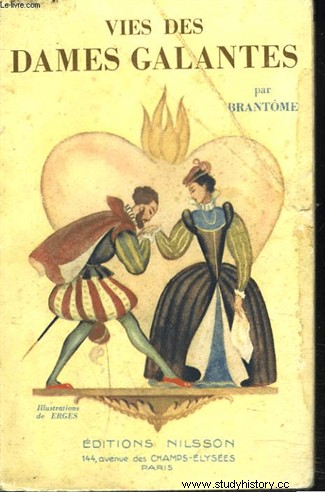 Pierre de Bourdeille , Lord of Brantôme (c. 1540-1614) was an abbot, then a soldier, courtier and writer in the 16th century. Brantôme first distinguished himself at court and on the battlefields:he was on several military expeditions, in Italy, France and Africa. A fall from his horse in 1583 made him give up military life and gave him the opportunity to shine as a brilliant memoirist. His Memoirs, which he announced in his will, were only published in 1665. This work is a series of anecdotes about the characters he had met at court. The most famous and commented chapters are the “Lives of gallant ladies” and the “Lives of illustrious men and great captains”.
Pierre de Bourdeille , Lord of Brantôme (c. 1540-1614) was an abbot, then a soldier, courtier and writer in the 16th century. Brantôme first distinguished himself at court and on the battlefields:he was on several military expeditions, in Italy, France and Africa. A fall from his horse in 1583 made him give up military life and gave him the opportunity to shine as a brilliant memoirist. His Memoirs, which he announced in his will, were only published in 1665. This work is a series of anecdotes about the characters he had met at court. The most famous and commented chapters are the “Lives of gallant ladies” and the “Lives of illustrious men and great captains”.
Origins of Pierre de Brantôme
Pierre de Bourdeille was born in 1540 in Périgord, in a military environment on his father's side and courtiers and writers on his mother's side. While her grandmother was lady-in-waiting to Marguerite d'Angoulême, sister of François I, her mother belonged to the group that wrote the Heptameron, her father fought alongside Bayard during the Italian campaigns and one of her sisters is part of the flying squadron of Catherine de Medici, these noble young ladies using their charms for diplomatic purposes...
 After spending his childhood at the court of Marguerite, he went to Paris to learn Latin and Italian then finished his studies in Poitiers in 1555. For the death of his brother killed in battle, Henri II thanked him by granting him the Abbey of Brantôme; Pierre de Bourdeille thus takes the name of Lord of Brantôme.
After spending his childhood at the court of Marguerite, he went to Paris to learn Latin and Italian then finished his studies in Poitiers in 1555. For the death of his brother killed in battle, Henri II thanked him by granting him the Abbey of Brantôme; Pierre de Bourdeille thus takes the name of Lord of Brantôme.
His life as a soldier and courtier
After his visit to Italy and his "honest" courtesans, he became attached to the Guises and was part of the guard that accompanied Mary Stuart to Scotland in 1561 after her death of Francis II. Back in France a year later, he received a pension as a gentleman of the King's Chamber of Charles IX, while participating in the first wars of religion. Between two wars, he stays in Malta because he is very attracted by the life of the Knights.
Under Henry III, he took part in all wars, without however managing to shine and obtain honours. He then decides to put an end to his military career in 1574. At the Court, he looks for a good match, but has no more luck. He is content to follow her, recording in his memory all the intrigues, rivalries and manners of his time.
In 1582, when Henry III did not keep his promise to give him the office of Seneschal of Périgord, Brantôme became angry and left him to join his brother François d'Alençon . Two years later, on the death of the Duke of Anjou, his master, he was ready to betray France by giving himself up to Spain, but he suffered a serious fall from his horse. He is forced to remain motionless in his property for two years.
Women's Lover
From that date, reclusive in his properties in Brantôme and Richemont for the last thirty years of his life, he shaped his memoirs in the form of stories of war and of travel as well as chronicles of the XVI th century, by dictating more than 4000 pages to his secretary. Courtier, he collected the facts and gestures of everyday life, made very flattering portraits and knew how to tell in a very skilful way the loving gesture of his contemporaries. Having been part of the king's close court, he entered into the intimacy of the princes, he knew the great ladies of his time, such as Queen Margot or Catherine de Medici, whom he described well in his biographies and whom 'he especially loved.
A lover of women, he was a true fetishist of pretty legs, saying that "many gentlemen, before wearing their silk stockings, begged their ladies to wear them for eight days" or "a beautiful leg and a beautiful foot have great favor and power in the empire of love". There were then disputes at Court as to whether a leg is more beautiful bare than covered. “The bare leg could only be shown in bed; if she was shown walking, the lady lacked decency and she had to at least wear a court shoe or a velvet slipper. The breeches (the stockings) had to be stretched and attached to a pretty garter”. It was therefore a glory to the Court of France to have beautiful legs; and Catherine de Medici “take care” of the beauty of her legs, she did not hide them either under her skirt or under her petticoat. She will thus wear boxer shorts of gold and silver canvas.
Brantôme, “light” writer
 Although he is considered a "light" writer, his most famous collection is "La Vie des Dames Galantes “, the term “galantes” meaning “pleasant, honest, of quality, of good company, of good humor” where he wrote “the ladies panicked with pleasure, enslaved to the whims of gentlemen delivered themselves shamelessly to all freedoms”. Brantôme admitted that ladies allow themselves to be courted “they are not passive and resigned victims, they experience desire, they give of themselves willingly but expect to be fulfilled. Beware of the failing lover! We kick him out if he does less than he promises”.
Although he is considered a "light" writer, his most famous collection is "La Vie des Dames Galantes “, the term “galantes” meaning “pleasant, honest, of quality, of good company, of good humor” where he wrote “the ladies panicked with pleasure, enslaved to the whims of gentlemen delivered themselves shamelessly to all freedoms”. Brantôme admitted that ladies allow themselves to be courted “they are not passive and resigned victims, they experience desire, they give of themselves willingly but expect to be fulfilled. Beware of the failing lover! We kick him out if he does less than he promises”.
He adds that in the 16th century, women were "much more ardent to the effects of love than men" and thus lists the ways to develop a happy sexuality which must be without constraint, thus usually exerting itself in illegitimate liaisons "if all the cuckolds and their wives who make them all held each other by the hand and it was possible to make a ring of them, I believe that it strong enough to surround and circle half the earth”.
Pierre de Brantôme died in 1614 in his castle of Richemont, but it was not until 1655 that his writings were published for the first time; it is still necessary to wait for the XVIII th century so that its reputation is made, although some regard the writings of Brantôme as a “collection of dubious and light anecdotes”. However, we can say that Tallemant-de-Réaux and Bussy-Rabutin are his descendants.
If he was not really a historian, Brantôme brought important testimonies on certain aspects of the life of the nobility of his time. He also knew how to charm by his talent as a storyteller and by the use of a picturesque language.
To go further
- Complete works of Pierre Bourdeille, Lord of Brantôme. Hachette BNF, 2013.
